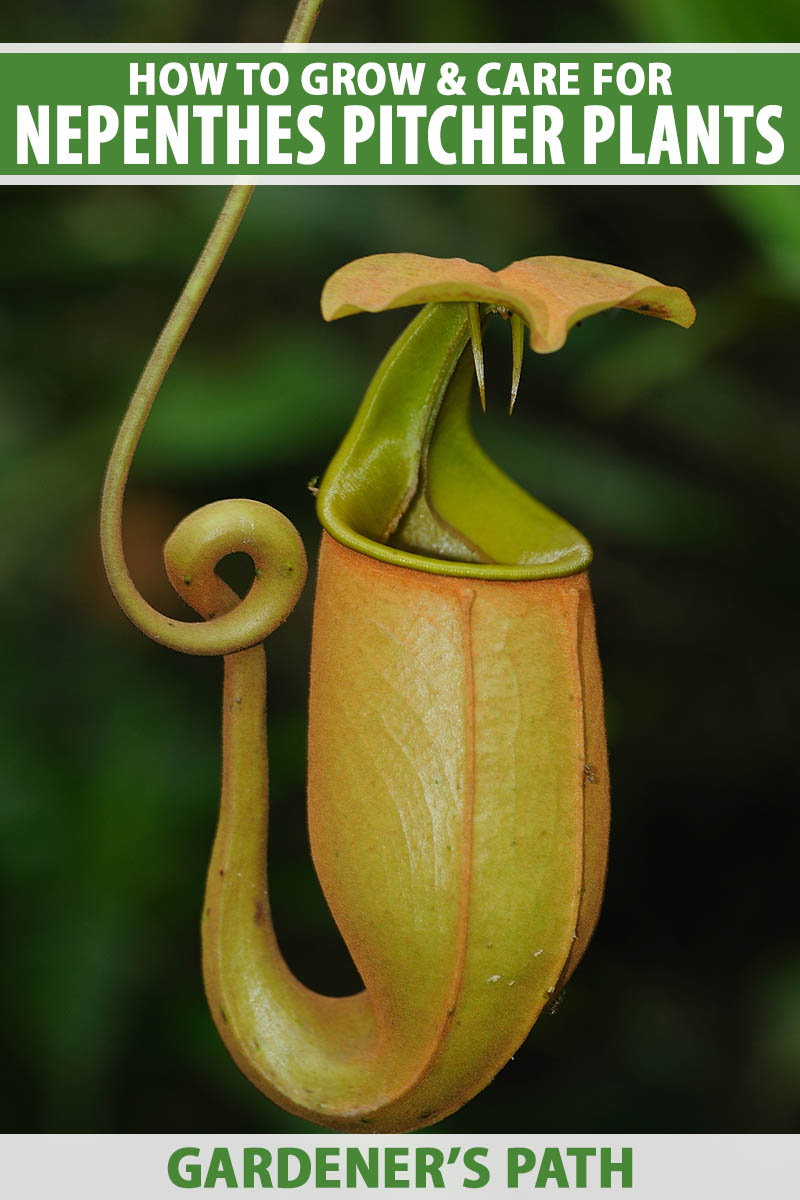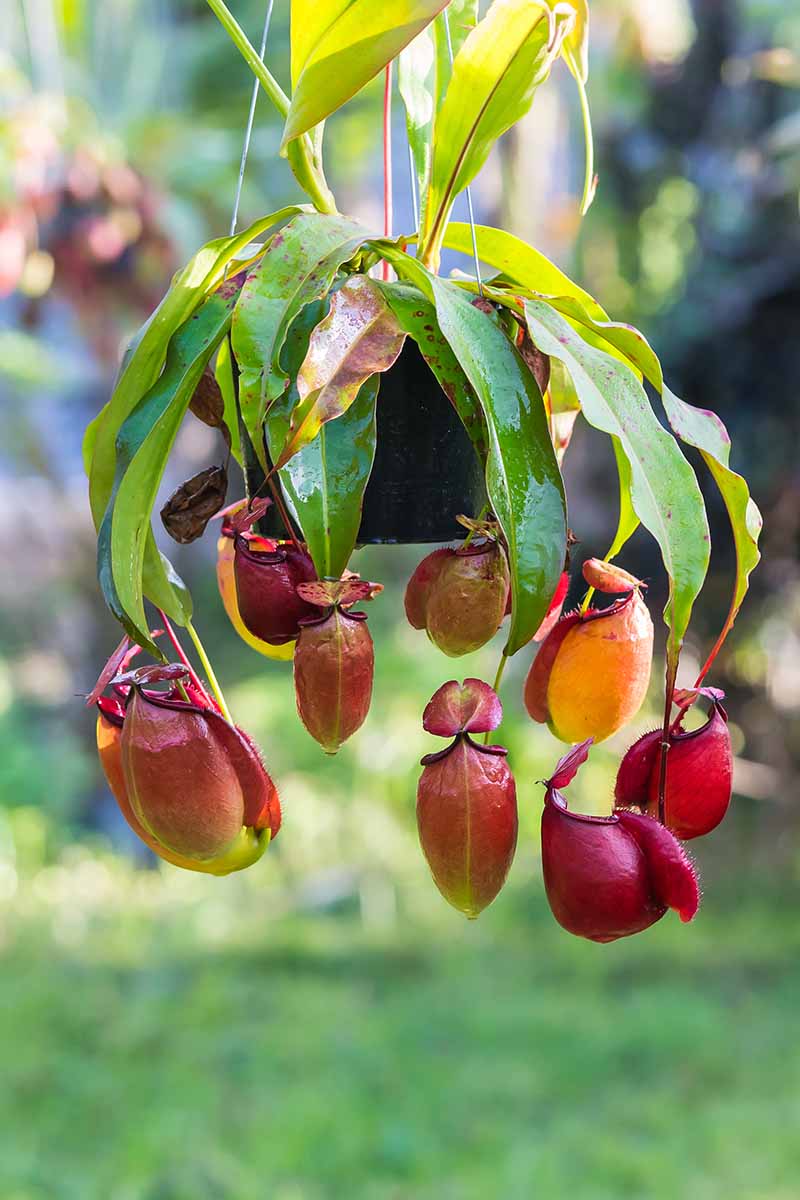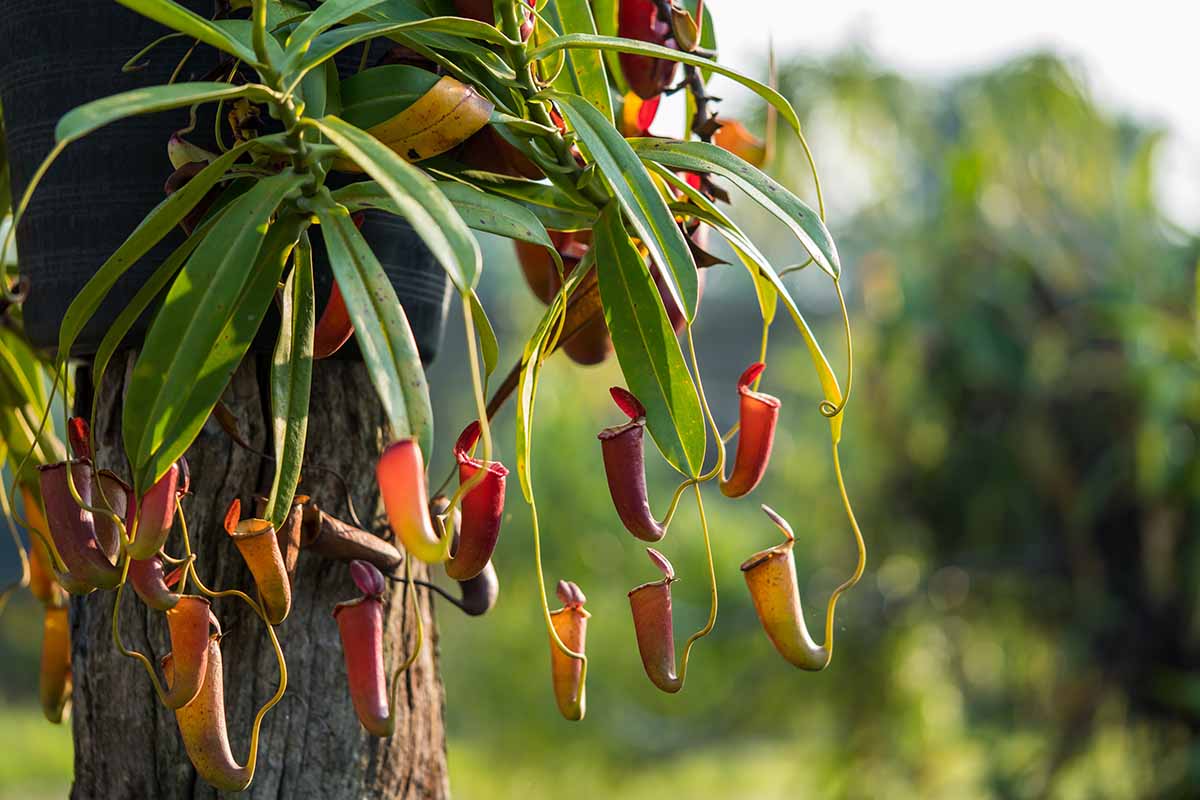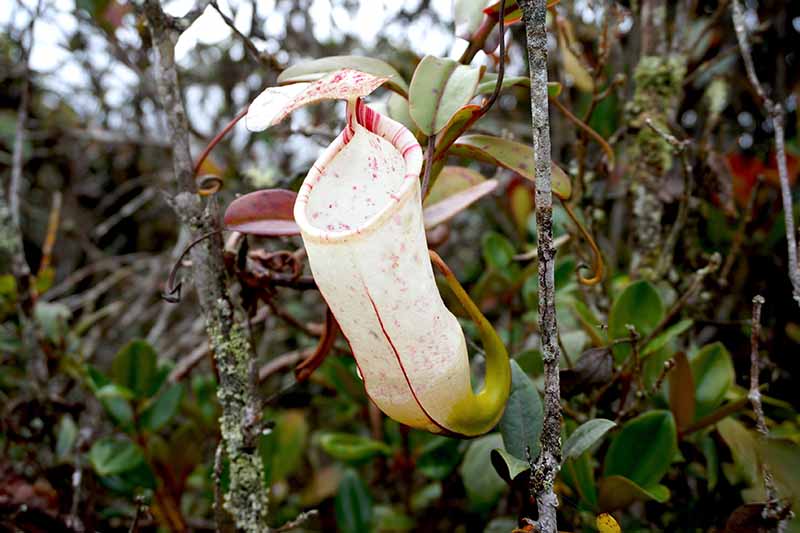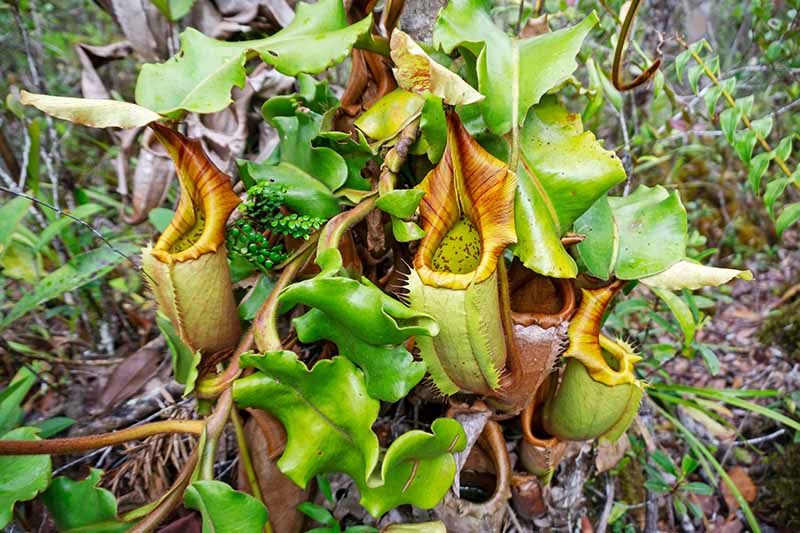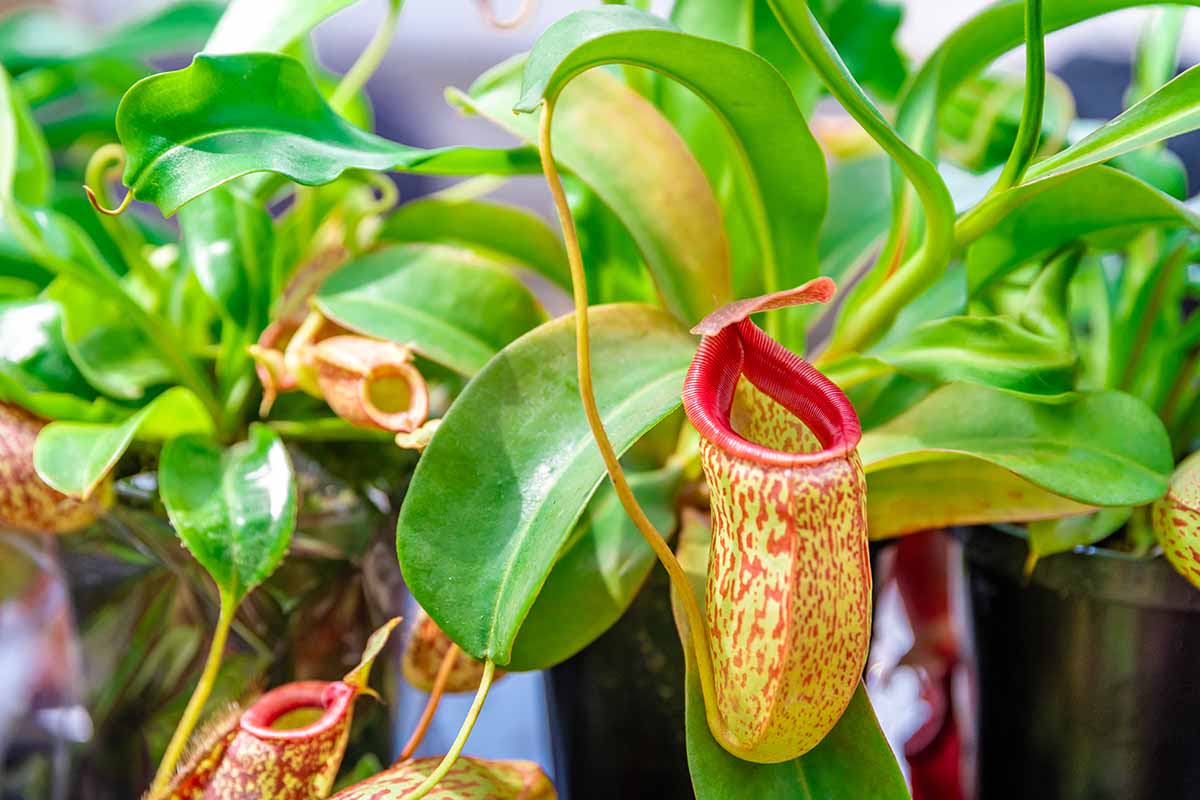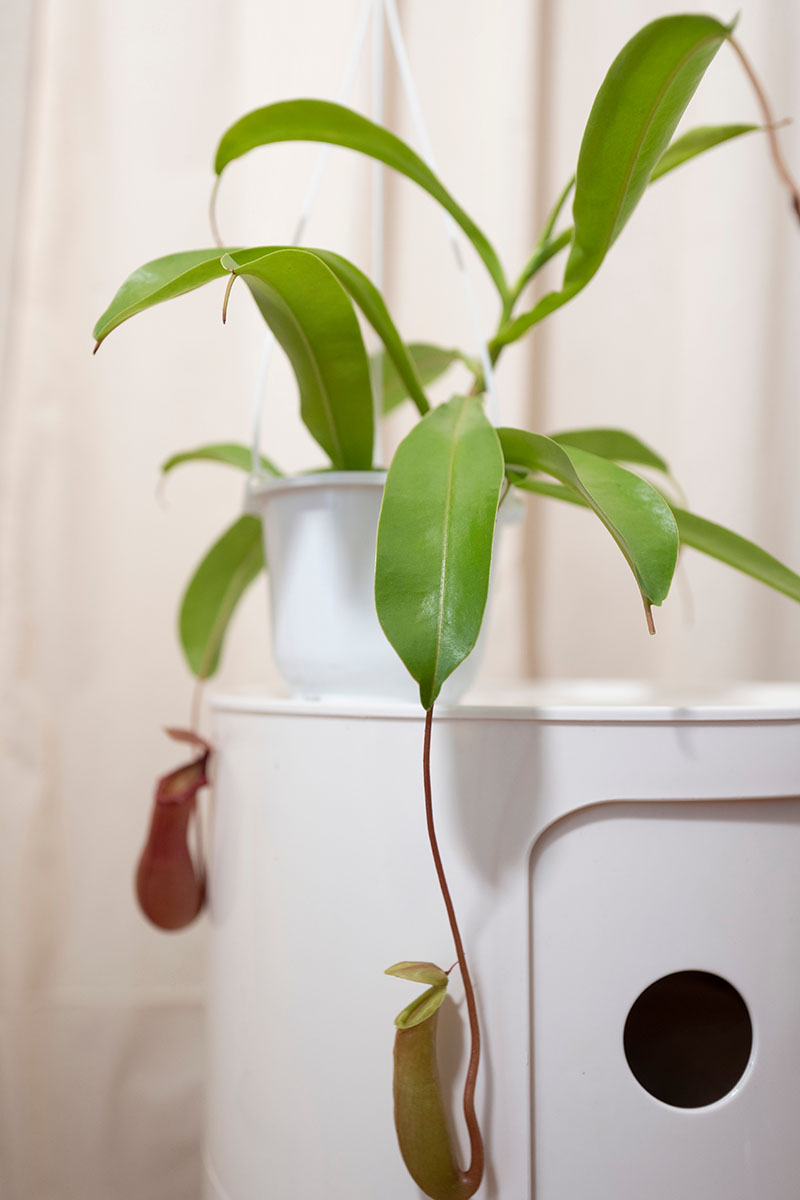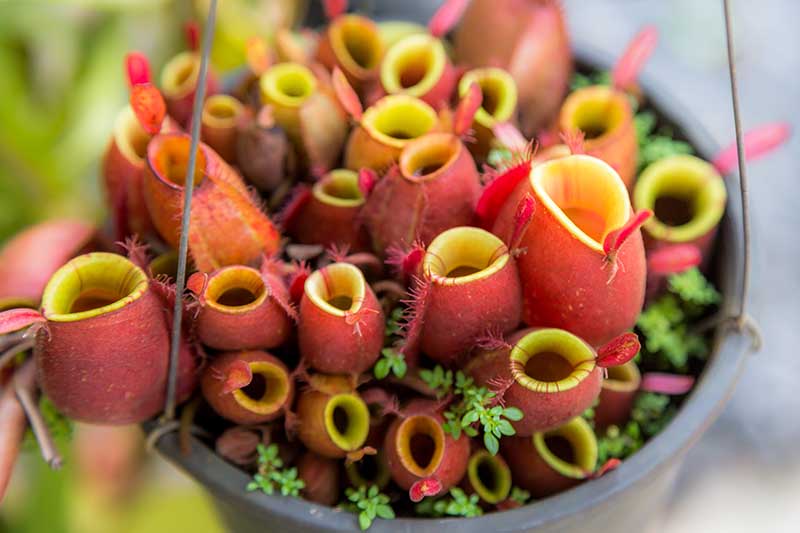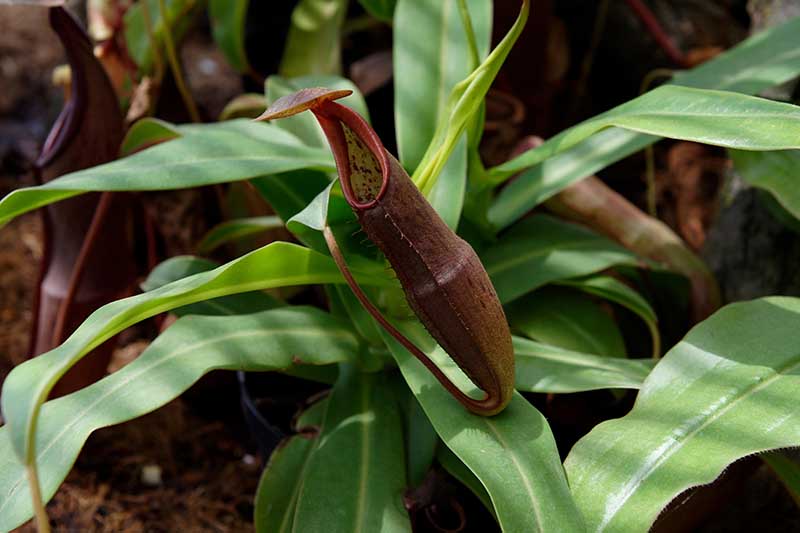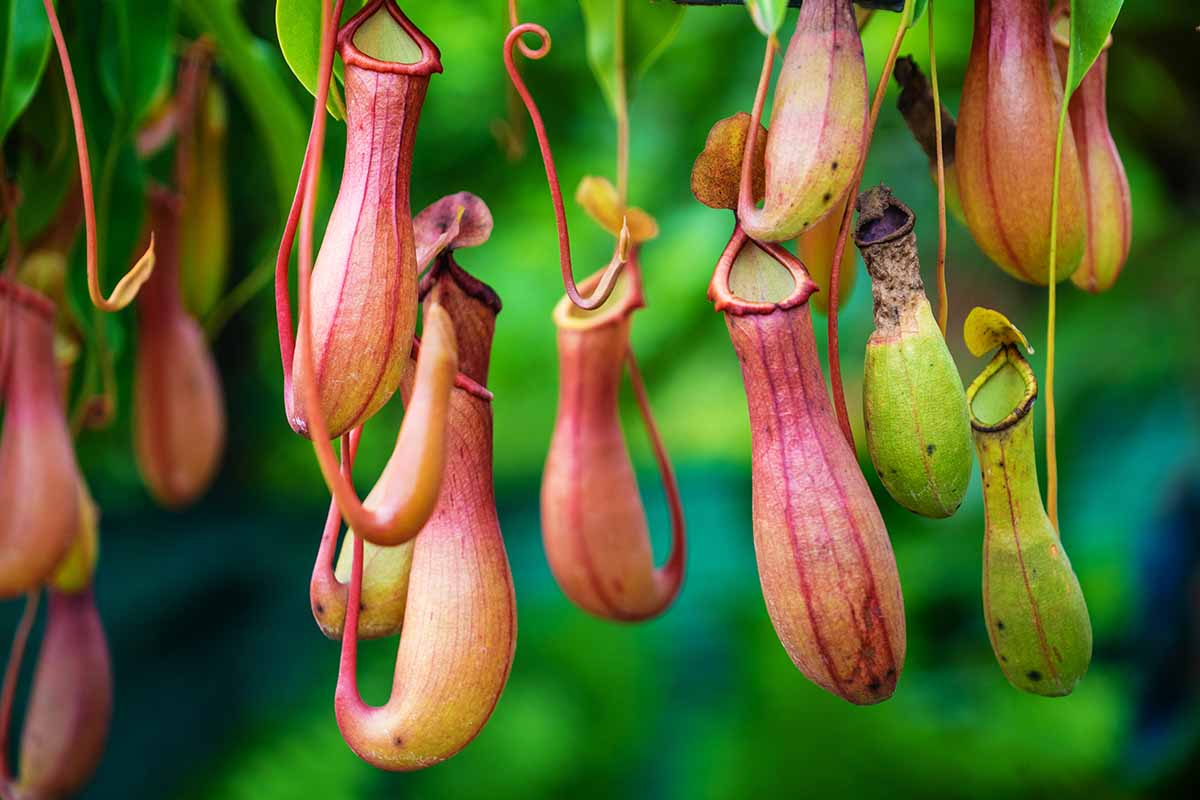Pitcher plants like species of the Sarracenia genus are among those that are a challenge to grow as houseplants because they have very specific needs. And some can grow very large, making it tough to find space for them indoors. Many of the carnivores are bog-dwellers that need wet soil and bright, direct sunlight for 12 or more hours per day to remain healthy, but others – like those of the Nepenthes genus – need very different conditions to flourish. We link to vendors to help you find relevant products. If you buy from one of our links, we may earn a commission. Here’s what we’ll cover:
What Are Nepenthes Pitcher Plants?
Tropical pitcher plants from the Nepenthes genus are primarily native to parts of Southeast Asia, Madagascar, and Australia. Most are tropical perennials found on mountain slopes, where they appreciate the warm days and cool nights in humid surroundings. A few are even tropical alpine varieties that can withstand freezing nighttime temperatures. You may see these plants referred to as “monkey cups,” as it was once thought that monkeys drank water from the vessels they produce. Alas, this has turned out not to be the case, though the name has stuck. With shallow roots and climbing stems, many varieties have a vining habit. Long, straplike leaves are produced along the stems. The pitcher traps contain fluid that is used to drown and digest their prey, and a waxy coating inside paired with downward-facing hairs make escape difficult. Their prey consists mostly of insects, though rodents, lizards, and birds are known to have been trapped by these carnivorous plants as well. Many species also have a lid, or operculum, that grows above the pitchers to prevent the digestive liquid inside from becoming diluted when it rains, though some species do not produce these. The flowers that they produce are pollinated by insects, and they can feature a range of different aromas ranging from a sweet scent to one that’s more fungal – and perhaps less appealing to humans! Something unique about these varieties of pitcher plants is that they actually produce two types of traps, typically with larger ones that sit on the ground near the base of plants, as well as aerial pitchers that may exhibit a different appearance or features. Seeing both of these is most common among mature plants in the wild. While plants in this genus are not known to be toxic to pets, they can cause mild digestive distress in cats when ingested. It can be a challenge to keep your feline friends away from the dangling pitchers, but hanging them near the ceiling and away from furniture, or potting them in a terrarium and out of reach, can do the trick. One of the most important things you need to know about members of the Nepenthes genus is that their care is not one-size-fits-all. They’re grouped into two types, the highland and lowland species, and these have distinct needs. The two types are further divided into epiphytic and cluster-forming specimens, and again, they have their own specific preferences and requirements as well.
Recommended Growing Conditions
Of the 170 species in the Nepenthes genus, most are paleotropical, meaning they originate from regions where the environmental conditions are warm and humid year-round. I often compare their care to that of tropical orchids like those of the Phalaenopsis genus, as they prefer very similar conditions, and generally grow in the wild in similar regions. If you’ve kept orchids alive and well already, you may have an easier time adjusting to providing for tropical pitcher plants. If not – no worries, you’ll soon get the hang of it. While some species are terrestrial varieties that grow in the ground, it’s important to know that many specimens are epiphytes, or climbing vines that need support and pruning, as they will often continue to grow unchecked until you cut them back. We’ll cover this more in the section on pruning and maintenance below. To keep them healthy and growing, you’ll need to mimic all or most of these conditions inside your home. This may sound pretty difficult, but it really boils down to just six factors: Since these are the same elements you’d need to address when caring for most houseplants, you can see that it’s not so difficult to sort out if you know which category your pitcher plant falls into – you’ll just need to strike the proper balance for each of these. Let’s cover the basic growing conditions that are fairly consistent across the board first.
Airflow
While highland specimens prefer more airflow than lowland species, both will suffer without it. Proper air circulation helps to prevent humidity from damaging delicate leaves as it settles, wicking any standing water droplets away before they can invite diseases such as botrytis or other fungal or bacterial infections to take hold. Airflow is also very important when bright sunlight and warm temperatures consistently converge, as it helps to prevent overheating. This is especially vital for highland varieties of pitcher plants.
Soil
A bag of potting soil from your local garden center might seem like a logical starting point, but it spells certain death for plants in the Nepenthes genus. Not only is it too dense, holding excess moisture that the plants will not tolerate, it’s also generally less acidic than these plants require, and full of potentially harmful nutrients and minerals. Perhaps the next logical choice would be a substrate that’s formulated specifically for carnivorous species. If you were growing a Venus flytrap or a sundew, I’d agree – but in this case, you’ll want to skip that as well. Though this type of potting soil offers a better balance of acidity and a lean nutritional makeup, it’s also heavy and designed to retain water. Instead, look for a potting mix designed specifically for growing Nepenthes. Or, if you really want to be sure you’re providing the good stuff, you can mix your own. A blend of one part each of sphagnum moss, perlite, and orchid bark is perfect. It allows all of the excess moisture to drain away, but holds just enough to slow drying out. It also allows for excellent airflow, and will help to keep the roots healthy.
Sunlight
In the wild, these plants would be found growing under the forest canopy, which would diffuse light and provide protection from scalding and overheating. Because of this, indirect but bright light is best when growing tropical pitcher plants indoors. Choose a location near a sunny window, but not directly in front of it if it receives more than a few hours of direct sun per day. You can pull a sheer curtain across the window to diffuse the harshest light of the day if you have a location in mind inside your home that is a bit too bright, but works otherwise.
Water
Carnivorous plants have developed methods of luring and digesting prey as an adaptation to growing in substrate that is highly acidic, and very low in nutrients and minerals. This modification has made it possible to survive where the growing conditions are less than hospitable, but has also made it nearly impossible for them to take nutrients up through their roots without killing or damaging them. While tropical pitcher plants are slightly more tolerant of soil that contains nutrients as compared to some other types of carnivorous plants, it’s best not to chance it by introducing minerals and other elements from a water source, as these can build up over time – particularly if you’re a beginner at pitcher plant keeping. Instead, using distilled water is best, or you may use rainwater. Next, let’s look at the specific conditions to keep in mind for highland and lowland species. It’s also important to note that some types fall somewhere between highland and lowland preferences, growing in intermediate areas in the wild where temperatures and growing conditions overlap a bit. These typically prefer warm days, warm to slightly cool nights, and consistent humidity. Make sure you know which type you’ve selected to determine its needs.
Highland Species
These are the more needy variety of the two types. Species that belong to this group generally grow in elevations above 3,000 feet in the wild. They appear in misty mountain forests where daytime temperatures are warm, and nights are cooler. Humidity from misty or foggy conditions in their native environment helps to keep the substrate that they grow in moist but not wet, and as a result, the roots are intolerant of drying out. When kept as houseplants, you’ll need to make sure you provide just enough moisture to always keep the substrate slightly damp to the touch. Also keep the following requirements in mind:
Humidity
Highland varieties will enjoy being positioned in an area where humidity is naturally high without consistently high heat, such as a bathroom window. They’ll thrive in the moisture created by daily showers, provided the room stays cooler in between. If your bathroom is windowless, you can place them elsewhere and provide humidity through other means, as discussed in the How to Grow section below.
Temperature
During the day, temperatures should be between 70 and 85°F, and nighttime temperatures should remain cooler, in the 55 to 60°F range. Avoid exposing Nepenthes to chilly temperatures under 55°F.
Lowland Species
Varieties that appear in lowland areas are normally found in elevations below 3,000 feet, where humidity can become dense and is typically coupled with high heat. These are commonly found deep inside steamy jungle environments and in rainforest canopies where they enjoy warm days and nights, and constant, muggy humidity.
Humidity
Along with dappled or indirect sunlight, humidity should be supplemented daily. A tray or bowl filled with water and a layer of rocks or pebbles can be positioned under the container, which will add moisture to the air as it evaporates. You can use a humidifier in conjunction with this or instead.
Temperature
As these species prefer steamy conditions, temperatures should remain consistently in the 75 to 90°F range. Never let temperatures drop below 60°F, as this may cause die-off.
Container Selection
These species do not typically have deep or widely-spreading root systems, so they can be planted in a pot or terrarium, or you can create a stunning presentation by planting in a kokedama.
Propagation
Whether you opt to purchase a plant online or from a local nursery that specializes in carnivorous species, you will need to transplant it once you get it home. It’s also possible to propagate Nepenthes species at home by rooting stem cuttings. While these can be placed in a dish or on a stand, hanging them from the ceiling is an excellent option for growing tropical pitcher plants. Super Moss Kokedama Planter If you’d prefer to use a container or pot, don’t use unglazed ceramic as the clay can sometimes contain natural salts that may cause damage. Plastic pots can hold excess moisture, so you’ll need to monitor the soil to make sure it’s not too wet if you choose this option. Make sure you provide support for climbing varieties, such as a moss-covered pole or other sturdy structure, or suspend the container from a ceiling hook where the pitchers can hang down. Moss Poles for Climbing Plants Two-packs of stackable oak stakes covered in a coconut coir substrate are available for purchase from Walmart. Each pole measures 15.7 inches in length. Plants can be started from seed or propagated via tissue culture as well, though the former tends to be a time-consuming process, and the latter is best reserved for the pros who have access to the proper equipment. We’ll cover the best options for beginners here.
From Cuttings
This is an excellent option if you’re pruning back lengthy vines from your mature plants, or if you have a friend who’s already a well-seasoned pitcher plant gardener with cuttings to share. Existing plants will look more tidy and will be more manageable as a result of pruning, but rather than wasting the cuttings, you can put them to good use by starting new plants, and sharing them with friends. First, take a cutting from an existing mature plant that is actively growing, and be sure to use clean and sanitized gardening clippers. Choose soft, flexible, green growth to make your cut, rather than woodier, thick vines. Select a vine with at least three leaves, and make your cut at an angle between nodes. Remove all but the top two leaves, as well as any pitchers. If you like, scrape away the outer layer of the bottom inch of the cutting, and dip the scraped portion of the cut end in rooting hormone powder. Some gardeners recommend cutting back the remaining leaves as well to a length of about two inches, so they can still photosynthesize without taking too much energy away from root formation. Do not trim the growing tip of the vine. Fill a four-inch pot with drainage holes with a carnivorous plant mix that is suitable for pitcher plants, or your choice of sphagnum peat moss or large-fiber coconut coir. Moisten the substrate with distilled water. Make a hole in the center with your finger or a chopstick. Place the cutting in the hole to a depth of a few inches, being sure to bury one or more nodes, since these are the locations where roots will emerge. Firm the substrate gently around the cutting. Water it in well, and place the container in a warm place where it will receive bright but indirect sunlight. A humidity dome can be used to maintain moisture around the cutting, or you can improvise with a plastic bag wrapped around the container. Be sure to keep the rooting medium moist. Roots should develop within about a month, at which time your rooted cutting will be ready for transplanting. Avoid tugging on the roots, as these can break easily. Instead, carefully unpot your cutting to check for root growth.
Transplanting
After you’ve chosen a container that has good drainage, fill it with one part each of sphagnum moss, perlite, and orchid bark. Other blends of similar light materials can also work, but this mix will allow for adequate drainage and airflow. Otherwise, select a premade mixture formulated specifically for growing Nepenthes. Make a hole large enough to accommodate the root system and gently seat the plant into place, being careful not to damage the delicate, brittle roots. Instead of pressing the substrate down with your hands, lightly tap it on a hard surface to tamp it into place and settle. Water it in well and allow any excess moisture to drain off. Once per month, drench the substrate well to flush out any built-up salts or impurities and allow it to drain well. If you’ve purchased your plant from a grower that shipped your specimen directly to you, peek into the pitchers to make sure they haven’t lost all their fluids. This is common in shipment and can be taxing, as it takes time and energy for the plants to replace the lost liquid. You can add a few eyedroppers full of distilled water to each pitcher to prevent dehydration – just make sure you don’t fill them more than about a third of the way.
How to Grow
Now that you understand the general environmental conditions you’ll need to provide to successfully bring a tropical pitcher plant into your home, let’s talk more about caring for your Nepenthes year-round. Make sure your plant is receiving at least eight to 12 hours of indirect sunlight per day, and if you don’t have a location that can provide this, consider using a grow lamp with LED bulbs that offer a soft glow that won’t scorch your plants. Just be sure to move the light far enough away to avoid burning or quickly drying the substrate out. Generally, 12 to 18 inches above the tops of the plants is sufficient. Don’t use regular tap or bottled water, as it typically contains dissolved nutrients and minerals that can cause damage. Instead, use distilled water whether you’re top or bottom watering, or misting, to avoid the potential for harm. Learn more about the best methods for watering Nepenthes in our guide. As I mentioned, placing your plant in a bathroom window works well for highland species. If you have a windowless bathroom, you can place them elsewhere in a sunny window but out of direct sunlight and use a humidifier to add moisture to the air for two to three hours each day. Air circulation is imperative to the health of the specimen, especially if you’ve chosen a highland variety. It’s important that the roots have adequate oxygenation to deter root rot and disease spread. A humidity tray can be positioned below the container and filled with water that will evaporate over time. Choose one with a grate on top or fill it with stones to keep the roots above the water level. Humidity Tray with Stones If the humidity is inadequate, you may notice that new pitchers are no longer being produced, and existing leaves and pitchers are beginning to dry out and turn brown. Water droplets that remain on the leaves and pitchers also increase susceptibility to disease. Air circulation will dry these up before they can cause a problem, and you can also dab away any that you see with a clean cloth. Provide a small fan to circulate indoor air for a few hours per day, and move your plants outdoors to a shady location on days when temperatures are within a favorable daytime range for the species you’ve chosen if you’re able to. Lowland species will relish being outside during muggy summer storms as well. You’ll need to feed your pitcher plant year-round, as these species do not have a dormant period. Small insects such as mealworms or small crickets – usually available at aquarium supply stores – can be dropped into one or two of the more mature pitchers that are over one inch in width on a weekly basis. Don’t overfeed them, however, as this can lead to die-off. Avoid adding fertilizers of any kind unless you’re an experienced grower. Even a small amount can damage or kill your plant. If they’re kept well-fed with insects, they won’t need it anyway.
Growing Tips
Provide 8 to 12 hours of indirect sunlight per day, or use a grow light.Choose a warm, humid location.Always use distilled water, avoid municipal water.Feed your plants year-round with mealworms or small crickets.
Pruning and Maintenance
If you’ve chosen a climbing variety, you’ll need to snip the vines back as it grows to encourage the plant to fill out with a bushier shape. Otherwise, it will continue to grow indefinitely and the vines can become quite long. Pitchers that have devoured a few insects will naturally die off over time, wilting and turning brown. Those can be cut away to divert energy to other needs. Any leaves or pitchers that show signs of disease – such as spots, fungus, or mold development – should be trimmed away and discarded in the trash. Check the soil every six months or so and observe if it appears to have darkened or looks like it has decomposed. If you notice that it seems mushy when you press on it, you’ll need to repot the plant with fresh materials. Repotting is also important when the container has become too small, which you may notice if the potting mix is drying out too quickly. This can be a quick death sentence for these tropicals. Replace the potting mix and add the plant, but don’t press down on the substrate with your hands as this can damage the roots. Instead, tap the container gently on a hard surface to tamp the substrate down and settle into place, and then water it in well. There are more than 170 species to choose from, but some make better houseplants than others. Read on to learn about some of the most popular choices for home growing.
Species and Cultivars to Select
Even though there are a large number of different Nepenthes species, many are a challenge to keep healthy, and some are completely unsuitable for growing indoors. When you’re deciding on the one you’d like to incorporate into your home, bear in mind that its care is dependent upon whether it hails from a highland or lowland environment – although some are intermediary, falling between the two.
Managing Pests and Disease
Infestation by insect pests isn’t typically a problem for Nepenthes grown indoors, but keep an eye out for aphids, fungus gnats, mealybugs, and spider mites. Not only is N. alata one of the easiest to grow indoors, it’s also one of the larger-sized options, with mature pitchers growing between five and eight inches in length. Nepenthes Alata This is one of the most easily recognized varieties as well, with young pitchers coming in green to pink and maturing to a deeper pink to red. This specimen can tolerate direct morning sunlight as well.
Ampullaria
If the idea of feeding live insects to a plant turns you off, then N. ampullaria is exactly what you’re looking for. Rather than needing live or even dried prey, it feeds on detritus instead. In the wild, it grows in clusters along the jungle floor where its pitchers open toward the canopy. Since they aren’t lidded like most species, the open mouth allows for falling leaves and vegetation to enter, and the fluid inside begins to break it down. This is also a good choice if you’re outfitting a terrarium that will be used to house reptiles, amphibians, or insects, since there’s no danger of their being accidentally consumed.
Bill Bailey
This hybrid cultivar is a cross between N. singalana and N. ventricosa. The result is a plant with a semi-compact size and shape that produces four- to six-inch, deep pink to red pitchers that mature to dark burgundy. ‘Bill Bailey’ ‘Bill Bailey’ is known to be a relatively easy-care variety that grows well in conditions somewhere between what’s recommended for highland and intermediary varieties, though two highland types were crossed to produce it.
Diana
Produced by and named after Diana Cantley, co-owner of Borneo Exotics in Sri Lanka, this cultivar is known as one of the easiest to grow. ‘Diana’ A cross between N. ampullaria, N. ventricosa, and N. sibuyanensis, ‘Diana’ forms a compact cluster of leaves with small to medium, three- to four-inch-long pitchers that range in color from pink to deep red.
Sanguinea
One of the species most commonly chosen for indoor growing, N. sanguinea has a reputation for being a less needy highland type that is suitable even for beginners. The pitchers range in size from about four inches to nearly 12 inches, with an equally variable range of colors. I’ve seen red, yellow, orange, and even a red-purple form with an interior that is typically speckled with white.
Ventricosa
This species is known for its hardiness. While most Nepenthes plants begin to suffer in temperatures below 55°F, N. ventricosa is an intermediary species that tolerates lows down to about 45°F. Nepenthes Ventricosa It also remains compact, with immature pitchers in bright green with a red lip, or peristome, gradually maturing to a deeper red-burgundy. Diseases are not uncommon in these plants, but they can be largely avoided by taking care to provide the ideal conditions for the species that you are growing. Fungal infections caused by Botrytis and Cercospora species may become an issue for plants grown without adequate air circulation, those that are overwatered, or grown in potting medium that doesn’t drain well. Botrytis (aka gray mold) causes fuzzy mold to form on the foliage and the roots to rot. This is usually as a result of overwatering, too much humidity, or lack of light. In the case of infection, you’ll need to repot your plant in fresh potting medium, and dispose of any affected foliage or roots. Cercospora shows up as spots on the leaves that gradually become larger, and in the case of a severe infection, may cause die-off. This condition can often be confused with foliage that is damaged by too much light. If your plants appear to be suffering from disease or otherwise failing to thrive, check all aspects of your maintenance program and ensure that you are providing proper growing conditions. With a tropical pitcher plant, you don’t just get good looks – you get interaction, and the savage yet fascinating magic of nature dangling from a hook in your ceiling. We’d love to know which you’re considering bringing home, or which you’re already growing. Show off a bit by sharing some pictures in the comments below! We’re happy to help with any questions you may have as well. And, if you’re simply enthralled with carnivorous plants and want to learn everything you can about them, you’ll want to check these titles out next:
How to Grow and Care for Pitcher Plants OutdoorsHow to Grow and Care for Sundew as a HouseplantHow to Grow a Venus Flytrap as a Houseplant
